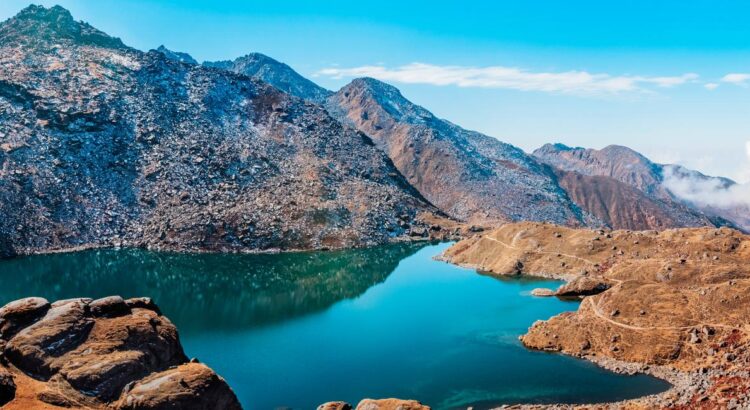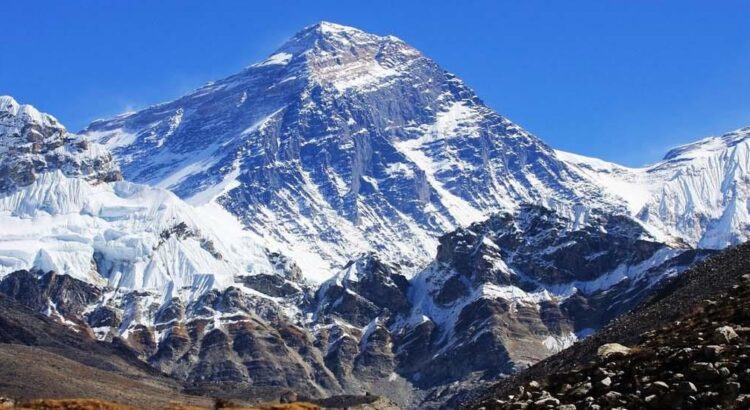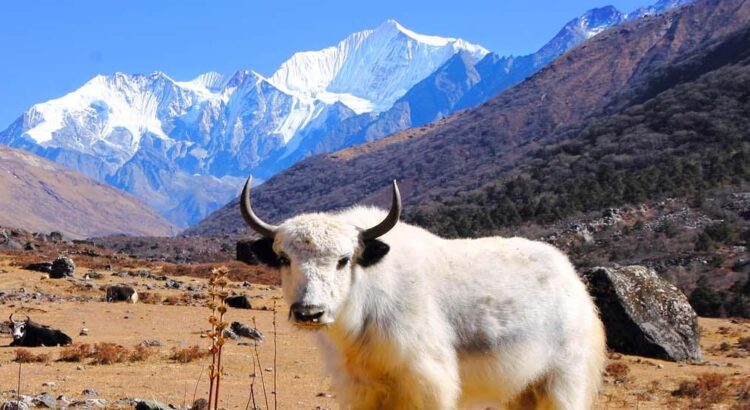Welcome to Nepal! If you’re ready for an adventure, embark on the breathtaking 15 Days Langtang Gosainkunda Trek. This trek combines the stunning landscapes of the Langtang Valley with the serene lakes of Gosainkunda, offering a diverse and unforgettable journey. Starting from Kathmandu, we drive to Syabrubesi, the gateway to the Langtang region. The trek takes us through lush forests, picturesque villages, and rhododendron-filled trails, eventually reaching the alpine meadows of Kyanjin Gompa. Here, we soak in panoramic views of snowy peaks like Langtang Lirung. Continuing on, we trek to the sacred lakes of Gosainkunda, a revered pilgrimage site. The trail presents a blend of nature and culture, encountering Tamang villages, prayer wheels, and yak pastures. Finally, we descend back to Sundarijal and return to Kathmandu. This trek promises an immersive Himalayan experience, ideal for nature enthusiasts and those seeking a glimpse of traditional Nepalese mountain life.
Introduction of Langtang Gosainkunda Trek
The Langtang Gosainkunda Trek is a mesmerizing journey through the Langtang Valley and up to the sacred lakes of Gosainkunda in Nepal. This trek offers a perfect blend of natural beauty and cultural immersion. Starting from Syabrubesi, the trail winds through dense forests, charming Tamang villages, and lush meadows adorned with wildflowers. As you ascend higher, you’ll be treated to stunning views of snow-capped peaks including Langtang Lirung. The highlight of the trek is reaching the pristine lakes of Gosainkunda, considered holy by Hindus and Buddhists alike. This trek is not only a feast for the eyes but also a chance to experience the unique mountain culture of the region.
Trip Highlights of Langtang Gosainkunda Trek
- Explore the charming villages of the Langtang Valley and interact with the friendly Tamang people.
- Trek through dense forests filled with rhododendron trees and diverse wildlife.
- Enjoy panoramic views of snow-capped peaks including Langtang Lirung and Ganesh Himal.
- Visit the ancient Buddhist monastery at Kyanjin Gompa and learn about Tibetan Buddhism.
- Reach the sacred lakes of Gosainkunda, a revered pilgrimage site for Hindus and Buddhists.
- Experience the unique blend of mountain landscapes, alpine meadows, and glacier-fed lakes.
- Encounter yaks grazing in high-altitude pastures and witness traditional Himalayan lifestyle.
- Immerse yourself in the serene atmosphere of the Himalayas and escape into nature away from city life.
Why Choose Langtang-Gosainkunda Trek?
The Langtang-Gosainkunda Trek is an excellent choice for trekking enthusiasts seeking a blend of natural beauty, cultural immersion, and a moderate level of challenge. Here are compelling reasons to choose this trek:
01. Stunning Scenery: The trek offers breathtaking views of snow-capped Himalayan peaks, lush forests, cascading waterfalls, and serene alpine lakes like Gosainkunda.
02. Cultural Experience: Encounter traditional Tamang villages, Buddhist monasteries, and yak pastures, gaining insight into the unique mountain culture of Nepal.
03. Varied Terrain: Trek through diverse landscapes ranging from verdant forests to high-altitude meadows, providing a rich trekking experience.
04. Less Crowded: Compared to popular Everest and Annapurna regions, Langtang-Gosainkunda Trek is relatively less crowded, offering a quieter and more peaceful trekking environment.
05. Accessibility: The trek starts from Syabrubesi, which is easily accessible from Kathmandu by road, making it convenient for travelers with limited time.
06. Wildlife: Encounter diverse flora and fauna, including rhododendron forests, Himalayan birds, and possibly even Himalayan wildlife like red pandas.
07. Spiritual Significance: Visit Gosainkunda, a sacred lake considered holy by Hindus and Buddhists, adding a spiritual dimension to the trek.
08. Affordability: The Langtang-Gosainkunda Trek is generally more affordable compared to other popular trekking routes in Nepal, making it a budget-friendly option.
Overall, the Langtang-Gosainkunda Trek offers a rewarding and authentic Himalayan experience without the crowds, making it an ideal choice for nature lovers and culture enthusiasts alike.
Langtang Gosainkunda Trek Itinerary
Day 01: Arrival at TIA Kathmandu (1400M)
Day 02: Sightseeing tour of Kathmandu
Day 03: Drive from Kathmandu to Syabrubesi (1480m) by bus 7-8 hours
Day 04: Trek from Syabrubesi to Lama Hotel (2380m) 6-7 hours
Day 05: Trek from Lama Hotel to Langtang village (3,430 Meters) 5-6 Hours
Day 06: Trek from Langtang to Kyanjin Gompa (3,860m)
Day 07: Acclimatization Day
Day 08: Trek back to Lama Hotel (2500m)
Day 09: Trek from Lama Hotel to Thulo syabru (2120m)
Day 10: Trek from Thulo syabru to Sing Gompa (3330m) 3-4 hours
Day 11: Trek from Sing Gompa to Gosainkunda Lake (4460m) 4-6 hours
Day 12: Trek from Gosainkunda to Sing Gompa (3250m)
Day 13: Trek from Sing Gompa to Dhunche (2,030m) 6 hours
Day 14: Drive from Syabrubesi to Kathmandu (1400M)
Day 15: Final Departure
Best Season for Langtang Gosainkunda Trek
The best season for the Langtang Gosainkunda Trek is generally considered to be during the spring (March to May) and autumn (September to November) months. During these seasons, the weather is stable with clear skies, making for excellent trekking conditions. The rhododendrons bloom in spring, adding vibrant colors to the landscape, while the autumn months offer stunning views of the Himalayan peaks against crisp, blue skies. These times also coincide with major festivals in Nepal, providing an opportunity to experience local culture along the trekking route.
Langtang Gosainkunda Trek Difficulty
The Langtang Gosainkunda Trek is considered moderately challenging, suitable for trekkers with a reasonable level of fitness and some hiking experience. The trail involves both ascents and descents through varied terrain, including forested paths, rocky trails, and occasional steep sections. Altitude gains are gradual but can still pose challenges for those not acclimatized to higher elevations. Trekkers should be prepared for trekking days of 5-7 hours on average. Adequate physical preparation and a steady pace will ensure an enjoyable and rewarding trekking experience in the Langtang region.
Accommodation Options on the Langtang Gosainkunda Trek
During the Langtang Gosainkunda Trek, trekkers can find a range of accommodation options to suit different preferences and budgets. The route offers basic teahouses and guesthouses in villages along the trail, providing simple yet comfortable lodging with shared facilities such as bathrooms and dining areas. As you ascend higher into the mountains, accommodation may become more basic, with fewer amenities available at higher altitudes. It’s advisable to carry a sleeping bag for extra warmth, especially during colder months. Overall, the accommodation options on the Langtang Gosainkunda Trek offer a cozy and authentic experience amidst the stunning Himalayan landscapes.
Meals Options on the Langtang Gosainkunda Trek
On the Langtang Gosainkunda Trek, trekkers can enjoy a variety of meal options provided at teahouses and guesthouses along the route. Typical meals include dal bhat (rice with lentil soup and vegetables), noodles, pasta, potatoes, and Tibetan bread. Local dishes and international fare such as pizza and momos (dumplings) are also available. Most teahouses offer set meal packages that include breakfast, lunch, and dinner. It’s recommended to try the local cuisine for an authentic Himalayan dining experience. Special dietary requests can often be accommodated, though choices may become more limited at higher elevations.
Required Permits for the Langtang Gosainkunda Trek
To undertake the Langtang Gosainkunda Trek in Nepal, several permits are required for trekking in the Langtang region. The main permits include the Langtang National Park Entry Permit and the TIMS (Trekkers’ Information Management System) Card. The Langtang National Park Entry Permit is necessary to enter and trek within the Langtang National Park, while the TIMS Card is issued for trekker safety and record-keeping purposes. These permits can be obtained through registered trekking agencies in Kathmandu or directly from the Nepal Tourism Board. It’s essential to carry these permits throughout the trek as they may be checked at various checkpoints along the trail.
Guides and Porters Service on the Langtang Gosainkunda Trek
Hiring guides and porters for the Langtang Gosainkunda Trek can greatly enhance the trekking experience. Local guides are knowledgeable about the route, terrain, and culture, providing valuable insights and ensuring safety throughout the trek. Porters can help carry trekking gear, allowing trekkers to focus on enjoying the journey without the burden of heavy loads. Engaging guides and porters also supports the local economy and community. It’s recommended to arrange guide and porter services through reputable trekking agencies in Kathmandu or directly in Syabrubesi before starting the trek.
Transportation Services for Langtang Gosainkunda Trek
Transportation services for the Langtang Gosainkunda Trek typically involve a road journey from Kathmandu to the trek’s starting point, which is usually Syabrubesi. This road journey takes approximately 7-9 hours by bus or private vehicle, depending on road conditions and traffic. Trekkers can also opt for shared jeeps or private taxis for a faster and more comfortable ride. Once the trek is completed, transportation is arranged back to Kathmandu from Sundarijal or Dhunche, depending on the specific trekking route chosen. It’s advisable to book transportation services through a reliable trekking agency or transportation provider in Kathmandu to ensure a smooth journey to and from the Langtang Gosainkunda Trek.
Langtang Gosainkunda Trek Route
The Langtang Gosainkunda Trek typically starts from Syabrubesi, which is accessible by road from Kathmandu. From Syabrubesi, trekkers begin their ascent into the Langtang Valley. The route passes through villages like Lama Hotel, Langtang Village, and Kyanjin Gompa, where trekkers can visit a Buddhist monastery and enjoy views of snow-capped peaks.
After Kyanjin Gompa, the trek continues towards the high-altitude lakes of Gosainkunda. The trail ascends to Laurebina Pass (4,610 meters), offering panoramic views of the Langtang range. Trekkers then descend to the sacred lakes of Gosainkunda, which are considered holy by Hindus and Buddhists.
After exploring Gosainkunda, the trek typically descends via Chandanbari and Dhunche before returning to Kathmandu. The total trekking duration is usually around 10 to 15 days, depending on the specific itinerary and pace.
Langtang Gosainkunda Trek Cost
The cost breakdown for the Langtang Gosainkunda Trek can vary depending on individual preferences and the level of services chosen. Here’s a general breakdown of the main expense categories and their estimated prices:
01. Permits:
Langtang National Park Entry Permit: Approximately $30 to $35 USD per person.
TIMS (Trekkers’ Information Management System) Card: Approximately $10 to $20 USD per person.
02. Transportation:
Kathmandu to Syabrubesi (and return):
Public Bus: $10 to $15 USD per person each way.
Private Jeep or Car: $100 to $150 USD per vehicle each way (shared among passengers).
03. Accommodation:
Teahouses or Lodges: $5 to $15 USD per night per person, depending on the location and level of comfort.
04. Meals:
Three meals a day (breakfast, lunch, dinner) at teahouses: Approximately $15 to $20 USD per day per person, depending on food choices.
05. Guide and Porter Services (optional but recommended for a more enjoyable experience):
Guide: $25 to $30 USD per day.
Porter: $20 to $25 USD per day (can carry up to 15-20 kg of trekking gear).
06. Miscellaneous (estimated):
Trekking gear rental (if needed): Varies depending on the item (e.g., sleeping bag, trekking poles).
Tips for guides and porters: Customary and appreciated, typically 10% to 15% of the total trek cost.
Overall Estimated Cost Range:
Basic Budget Trek (10-15 days): $600 to $800 USD per person.
Standard Trek with Guide and Porter Services (10-15 days): $800 to $1200 USD per person.
These estimates are approximate and can vary based on the trekking season, group size, and individual preferences. It’s recommended to contact reputable trekking agencies in Kathmandu for detailed quotes and to discuss specific requirements for the Langtang Gosainkunda Trek.
Tips for Altitude Sickness Prevention on Langtang Gosainkunda Trek
01. Ascend gradually, allowing your body time to acclimatize to higher altitudes.
02. Maintain a steady pace while trekking and avoid overexertion.
03. Stay hydrated by drinking plenty of fluids, aiming for 3-4 liters of water per day.
04. Avoid alcohol and smoking, which can worsen altitude symptoms.
05. Include rest days in your itinerary to aid acclimatization.
06. Eat light, easily digestible meals and carry high-energy snacks.
07. Consider taking medication such as acetazolamide (Diamox) as a preventive measure (consult your doctor before use).
08. Be aware of symptoms of altitude sickness (headache, nausea, dizziness) and inform your guide or trekking companions if you experience any.
09. Descend immediately if symptoms worsen or persist despite rest and hydration.
Langtang Gosainkunda Trek FAQ(s)
1. How long is the Langtang Gosainkunda Trek?
The Langtang Gosainkunda Trek typically takes around 10 to 15 days, depending on the specific itinerary and pace of trekking.
2. What is the best time to do the Langtang Gosainkunda Trek?
The best times to trek in the Langtang region are during the spring (March to May) and autumn (September to November) seasons when the weather is clear and stable.
3. Do I need a permit for the Langtang Gosainkunda Trek?
Yes, you will need permits including the Langtang National Park Entry Permit and the TIMS (Trekkers’ Information Management System) Card.
4. Is altitude sickness a concern on the Langtang Gosainkunda Trek?
Yes, altitude sickness can be a concern as you ascend to higher elevations. It’s important to acclimatize properly, stay hydrated, and be aware of symptoms.
5. What kind of accommodation is available on the Langtang Gosainkunda Trek?
Accommodation options include basic teahouses and guesthouses along the trail, offering simple rooms with shared facilities like bathrooms and dining areas.
6. Are there ATM facilities along the Langtang Gosainkunda Trek?
ATM facilities are not readily available along the trekking route, so it’s advisable to carry enough cash (Nepalese rupees) from Kathmandu.
7. Do I need to hire a guide or porter for the Langtang Gosainkunda Trek?
Hiring a guide or porter is optional but recommended for safety, navigation, and to enhance the overall trekking experience.
8. What kind of wildlife can I expect to see on the Langtang Gosainkunda Trek?
You may encounter various wildlife including Himalayan birds, langur monkeys, and if lucky, possibly red pandas and Himalayan thars.
9. How physically challenging is the Langtang Gosainkunda Trek?
The Langtang Gosainkunda Trek is considered moderately challenging. Regular exercise and basic fitness preparation are recommended.
10. What should I pack for the Langtang Gosainkunda Trek?
Essentials to pack include trekking gear (good hiking boots, warm clothing layers), personal medications, sunscreen, a reusable water bottle, and a camera to capture the stunning landscapes.
Conclusion of Langtang Gosainkunda Trek
The Langtang Gosainkunda Trek offers a captivating journey through the stunning Langtang region of Nepal, combining breathtaking natural landscapes with cultural immersion. Trekking through dense forests, quaint villages, and alpine meadows, and reaching the sacred lakes of Gosainkunda, trekkers experience the true essence of the Himalayas. The trek provides a balanced challenge with moderate elevation gains, making it accessible to trekkers of varying experience levels. Along the way, encounters with friendly locals, visits to Buddhist monasteries, and panoramic mountain views create lasting memories. The spiritual significance of Gosainkunda adds depth to the trek, reflecting Nepal’s rich cultural heritage. Overall, the Langtang Gosainkunda Trek promises a rewarding adventure filled with scenic beauty and cultural discoveries, making it a cherished experience for all who embark on this journey.








29.jpg)


